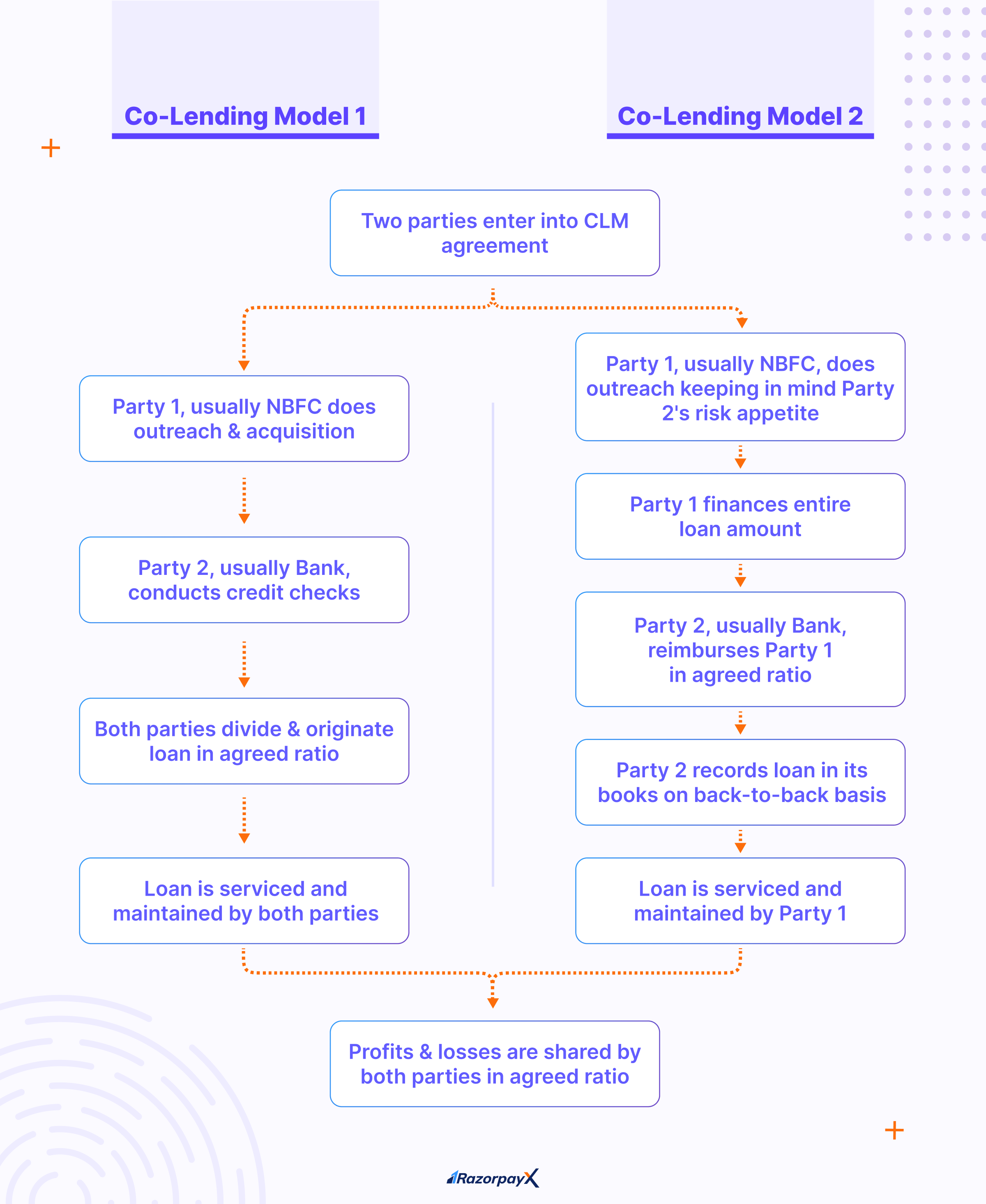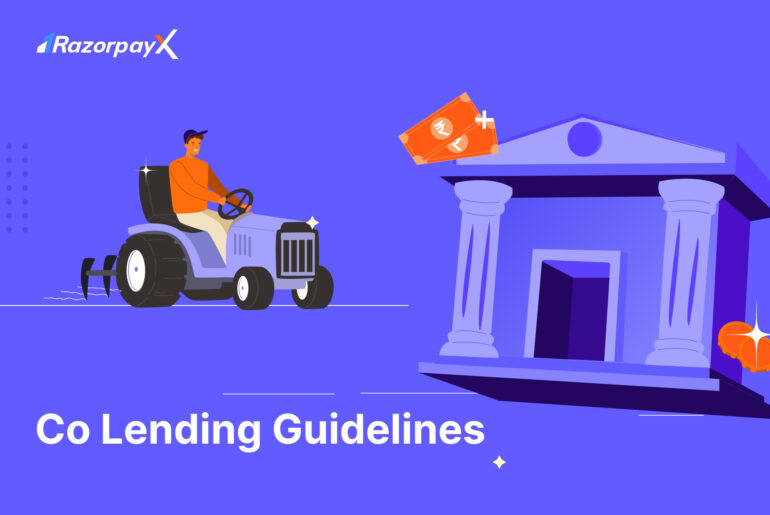Fact checked by Swaroop Kuruvadi, Product Manager of Escrow+ & Lending Products at RazorpayX
The first RBI co-lending guidelines were published by the RBI in 2018. Back then, it was known as co-origination, but the underlying concept of the model is the same.
Today, banks and NBFCs follow the latest RBI guidelines on co-lending, as published in the circular dated November 5th, 2020.
Here’s a breakdown of all the regulations around the co-lending industry.
Table of Contents
What is Co-Lending?
Co-lending is a bank-NBFC partnership model of lending while reducing the risk of non-repayment. Co-lending is most widely used by banks and NBFCs when lending to high-risk priority sector industries like agriculture and SMEs.
With co-lending, NBFCs can partner with bigger NBFCs or banks to unlock larger markets that they may not have access to due to a lack of resources.
Banks benefit from co-lending because it enables them to easily fulfil their priority sector lending requirements with minimal overhead expenses.
What is a priority sector? The RBI defines a priority sector as any sector which is crucial for the development of the country. These sectors are not always the most profitable investments, and so banks and other financial institutions might be reluctant to provide loans to businesses in these sectors.
The RBI mandates that commercial banks in India must dedicate 40% of their net credit to these priority sectors, which include agriculture, education, rural housing, social infrastructure and more.
How Does Co-Lending Work?
In the co-lending model, banks and NBFCs tie up to provide credit to borrowers. They share the risks and the rewards of lending.
There are two models of co-lending. While RBI co-lending guidelines don’t specifically mention these two models separately, the industry has adopted the following structure:
 CLM 1 (Co-Lending Model 1): Under this model, both parties divide and disburse the loan at the same time. The loan is originated and maintained on both sides.
CLM 1 (Co-Lending Model 1): Under this model, both parties divide and disburse the loan at the same time. The loan is originated and maintained on both sides.
CLM 2 (Co-Lending Model 2): Under this model, the NBFC originates and disburses the loan, after which the bank reimburses up to 80% of the loan to the NBFC.
The bank then retains its share of the loan in its balance sheet on a back-to-back basis enabling it to count towards the bank’s priority sector lending targets.
In this way, banks can expand priority sector lending without directly engaging in the origination and servicing of these loans; NBFCs can expand their reach and service sections of the economy previously reserved for the more robust banks and NBFCs.
RBI Co-Lending Guidelines
Here is a simplified breakdown of the RBI co-lending guidelines.
Scope of Co-Lending
The NBFC and the bank must establish a mechanism to check creditworthiness since the RBI mandates that credit sanctioning cannot be outsourced. Ex-ante due diligence must be carried out by the bank and the NBFC directly.
The bank must ensure KYC compliance as per the RBI mandate. This KYC due diligence can be carried out by a third party, subject to conditions like the third party not being based in a country assessed as high risk.
The bank must ensure compliance with the Revision to the Guidelines on Securitisation Transactions circular issued by the RBI in 2012.
The guidelines also cover the Minimum Holding Period (MHP), which stipulates that banks must retain a certain portion of co-lending loans for a certain period. For example, for loans to the non-priority sector, the minimum holding period is 3 months in case of loans of up to 2 years.
The MHP is waived in certain cases, like when the agreement between the NBFC and the bank contains a back-to-back clause.
The bank also cannot enter into a co-lending agreement with an NBFC owned by the promoter group.
Customer-related issues
The NBFC is the single interface point for customers – the roles and responsibilities of all parties involved must be detailed in an agreement.
The final borrower is to be charged an all-inclusive interest rate that is agreed upon by both the NBFC and the bank.
The NBFC should have enough information to generate the customer’s account statement. To do this, the NBFC and banks can enter into information-sharing agreements.
The NBFC should ensure a grievance redressal system is in place to resolve any complaint the borrower raises.
Other Operational Aspects
The bank and NBFC must maintain individual borrower’s accounts for their respective share of the loan. However, all transactions between the NBFC and the bank must be routed through an escrow account to avoid the inter-mingling of funds.
Escrow Accounts for Co-Lending
The NBFC and bank shall decide on a framework to monitor and recover the loan and details of security and charges.
Any third-party involvement requires consent of both NBFC and the bank.
Finally, the NBFC and the bank must decide on a business continuity plan to ensure that borrowers get uninterrupted service despite terminating the co-lending agreement between the co-lenders.
Escrow Accounts for Co-Lending Partnerships
An important part of the co-lending infrastructure is the escrow account. All transactions related to the co-lending partnership have to go through an escrow account, which is held by the operating partner.
An escrow account ensures transparency and compliance with regulations. While traditional banks do provide robust escrow infrastructure for co-lending partnerships, the ease of use and user experience are severely lacking.
Fintech-enabled solutions like RazorpayX Escrow+ allow for incredible transparency and visibility for both parties.
Learn more about RazorpayX Escrow+
Future of Co-Lending
Co-lending is the future of digital lending, thanks to RBI co-lending guidelines. The guidelines motivate both banks and NBFCs to enter into co-lending partnerships, making this sector likely to grow significantly in the coming decade.
As fintechs like Smartcoin and Rupeek enter the co-lending space, this sector is bound to witness unprecedented innovation in the years to come.
FAQs
What is a co-lending agreement?
A co-lending agreement is a written contract signed by all parties involved in the co-lending arrangement; typically a bank and an NBFC. It includes all the important details to ensure that the co-lending arrangement is carried out smoothly from disbursal to collection.
What are the restrictions on co-lending by the RBI?
The RBI issued circulars to regulate the co-lending sector, to ensure safety of all the parties involved, including the NBFC, the bank and the borrowers. These regulations are explained in this blog.
What is the process of co-lending?
The process of co lending begins with an agreement. The NBFC and the bank enter into a formal agreement which outlines terms, risk sharing ratio, responsibilities and more. Originating the loan then becomes the responsibility of the NBFC - they conduct the due diligence and underwriting process. The banks then provide a portion of the loan as per the agreed ratio. The servicing of the loans may then shared between the NBFC and the bank.





